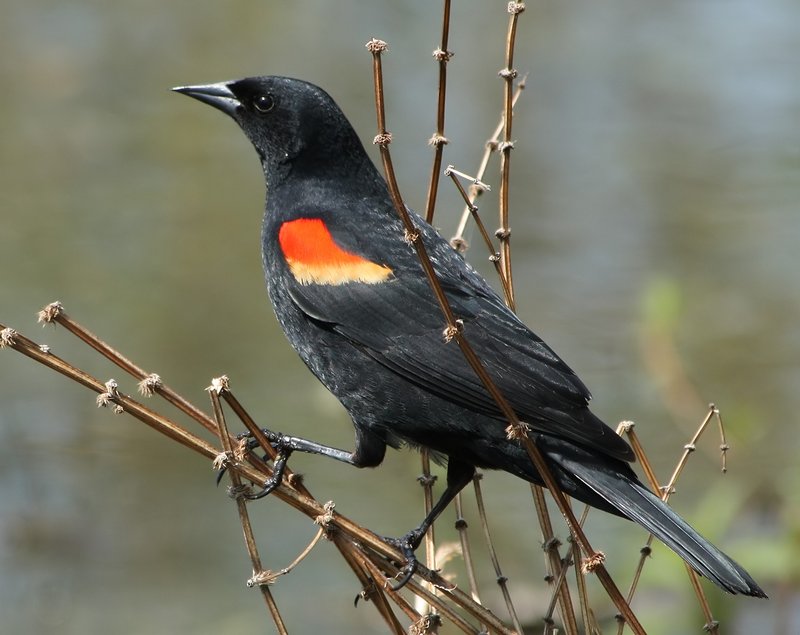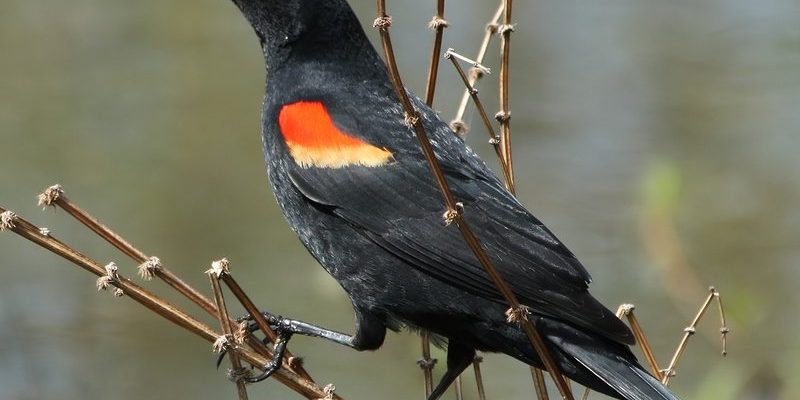
If you’ve spent time near wetlands or marshes, you may have encountered the striking Red-Winged Blackbird. With its glossy black plumage and unmistakable red and yellow shoulder patches, this bird is hard to miss. As you watch them dart through cattails or perch on a nearby branch, you can’t help but feel captivated by their beauty and unique behavior. They’re more than just a pretty face; these birds play a vital role in their ecosystems and exhibit fascinating traits that make them truly special.
Imagine standing by a peaceful pond, the air filled with the sounds of nature. Suddenly, you hear a sharp, melodic call that cuts through the background noise. That’s likely the vocalization of a Red-Winged Blackbird, a sound that adds to the symphony of the wild. These birds are social creatures, often seen in groups, which can make observing them an exciting experience. They have a rich mosaic of behaviors and interactions that can leave you feeling like you’ve stumbled upon a little world of their own.
Physical Characteristics
The Red-Winged Blackbird is a medium-sized bird, approximately 7.5 to 9.0 inches long. Males are easy to identify, sporting a shiny black body with striking red and yellow shoulder patches, known as epaulets. These vibrant markings serve a crucial purpose, not just for attracting mates but also for asserting dominance over territory. Female Red-Winged Blackbirds, on the other hand, have a more subdued appearance, with mottled brown and black feathers that provide excellent camouflage among their nesting habitats.
These birds are incredibly agile fliers, adept at weaving through vegetation with ease. When you observe them in flight, you’ll notice their pointed wings, which aid in quick, maneuverable movements. Their tail is also quite distinctive; it’s not just a simple black feathered end. Instead, it’s slightly longer, which helps them brake and change direction swiftly. If you’re lucky enough to spot a male in full display, perched proudly on a high branch, you’ll see how those bright red epaulets can catch the light, almost glowing against the dark backdrop of its feathers.
Habitat and Range
Red-Winged Blackbirds thrive in a variety of environments, primarily preferring wetlands, marshes, and along the edges of ponds and lakes. Their go-to habitats often include dense reeds and cattails, where they can find both food and shelter. It’s these unique environments that offer them abundant insects and seeds to feast on, as well as safe spots to nest and raise their young.
Geographically, these birds are widespread across North America, from southern Canada down to the Gulf of Mexico. Depending on the season, you might notice them migrate in large flocks, traveling to warmer areas during winter. Their adaptability to varied environments also contributes to their extensive range. Whether you’re in a bustling city park or a remote wetland, there’s a good chance you’ll encounter them as they adjust to their surroundings.
Behavior and Social Structure
Females, typically more discreet, play a crucial role in the social structure as well. They gather in groups for nesting, often building their nests in tall grasses. Once the young hatch, females are responsible for feeding and guarding them. You might see a female darting quickly away from her nest, a behavior designed to draw potential predators away from her vulnerable chicks. This protective instinct is a powerful reminder of how nature shapes behavior for survival.
Diet and Feeding Habits
The diet of the Red-Winged Blackbird is quite diverse, allowing them to take advantage of various food sources. They primarily feed on insects, seeds, and grains. During the warmer months, you’ll often find them foraging for insects, which are crucial for their protein intake, especially when rearing chicks. Their favorite snacks include beetles, grasshoppers, and caterpillars, which they skillfully extract from their environments.
In addition to insects, these birds enjoy seeds and grains, especially during the fall and winter when insects become scarce. They’ve been known to frequent agricultural fields, where they peck at leftover crops. This adaptability in diet not only supports their survival but also helps them thrive in different habitats. You might even notice them searching for food alongside other birds, which is a common behavior that highlights their social nature.
Breeding and Nesting
The breeding season for Red-Winged Blackbirds usually begins in late March and can extend into July. Males arrive at nesting sites first to establish territory, while females follow shortly after to choose a mate. Once a bond is formed, the female selects a site to build her nest, often hidden among thick reeds and grasses. This choice is not merely aesthetic; it helps protect her future offspring from predators.
Nesting is a team effort in a sense, but the bulk of the work falls on the female. She constructs the nest using grasses, reeds, and even mud to create a sturdy structure. After laying typically 3 to 5 eggs, she incubates them for about 11 to 14 days. During this time, the male guards the territory, warding off intruders and rivals with fervent displays of song and color. It’s a fascinating partnership that showcases the balance between cooperation and survival in nature.
Conservation Status
Currently, the Red-Winged Blackbird is not considered endangered, thanks to its adaptability and wide range. However, like many other species, they are impacted by habitat loss and environmental changes. Wetlands, their primary habitat, are diminishing due to urban development and agriculture, which poses a threat to their population. Monitoring programs and conservation efforts are crucial to ensuring these vibrant birds continue to thrive in their natural habitats.
As a bird enthusiast, you can contribute to their conservation by supporting wetland preservation initiatives or simply enjoying and respecting their natural environment. Every small action helps create awareness and boosts efforts to protect these lovely creatures and their homes, ensuring future generations can also experience the joy of seeing a Red-Winged Blackbird in the wild.
Interesting Facts
| Scientific Name: | Aglaiocercus kingii |
| Length: | 7.5 – 9.0 inches |
| Wingspan: | 12 – 15 inches |
| Weight: | 1.5 – 2.0 ounces |
| Life Span: | Up to 15 years in the wild |
| Diet: | Insects, seeds, grains |
| Habitat: | Wetlands, marshes, and along shores |
| Call: | Distinctive, melodic whistling |
FAQ
What is the range of the Red-Winged Blackbird?
The Red-Winged Blackbird is found throughout North America, from southern Canada to the Gulf of Mexico. Their adaptability allows them to thrive in various environments, particularly wetlands, marshes, and open fields. During migration, they can be seen in large flocks, traveling to warmer areas for the winter months.
How can you identify a Red-Winged Blackbird?
Identifying a Red-Winged Blackbird is relatively straightforward, especially with males, who are notable for their black feathers and bright red and yellow shoulder patches. Females are more cryptic, displaying a mottled brown color that helps with camouflage. Observing their behavior, like their distinctive calls and territorial displays, can also help differentiate them from other bird species.
What do Red-Winged Blackbirds eat?
Red-Winged Blackbirds have a varied diet that mainly consists of insects, seeds, and grains. They enjoy foraging for insects during warmer months, which provide essential protein for their young. In colder seasons, they tend to consume more seeds and grains, often found in fields and wetlands where crops are present.
Are Red-Winged Blackbirds social birds?
Yes, Red-Winged Blackbirds are known for their social behavior. They often form flocks, especially outside of the breeding season. Males are territorial during nesting, but they can be seen foraging and resting together in large groups throughout the year, showcasing their social nature.
How do Red-Winged Blackbirds nest?
Female Red-Winged Blackbirds build their nests in dense vegetation, usually near water. They use materials like grasses and reeds to create a sturdy structure. After laying eggs, the female incubates them for about two weeks while the male defends their shared territory.
What is the song of a Red-Winged Blackbird like?
The song of the Red-Winged Blackbird is quite distinctive and melodic, often described as a series of sharp whistles. Males sing to establish territory and attract mates, while their calls can be heard throughout their habitats, adding a unique auditory dimension to the landscape.
What threats do Red-Winged Blackbirds face?
While Red-Winged Blackbirds are not considered endangered, they face threats primarily from habitat loss due to urban development and agricultural practices. Wetland drainage and pollution can also impact their populations. Conservation efforts aimed at preserving these critical habitats are vital for their survival.
Why are Red-Winged Blackbirds important to their ecosystem?
Red-Winged Blackbirds play a significant role in their ecosystems by helping control insect populations and dispersing seeds. Their presence can indicate the health of wetland environments, making them crucial indicators of ecosystem stability and biodiversity.
Do Red-Winged Blackbirds migrate?
Yes, Red-Winged Blackbirds migrate seasonally. They typically leave their northern breeding grounds in the late fall, traveling in flocks to warmer regions for winter. They return to their breeding areas in spring when temperatures rise and food becomes plentiful.
How long do Red-Winged Blackbirds live?
The lifespan of a Red-Winged Blackbird in the wild can be quite impressive, reaching up to 15 years under optimal conditions. However, many factors, including predation and habitat changes, can affect their survival rates in the wild.

